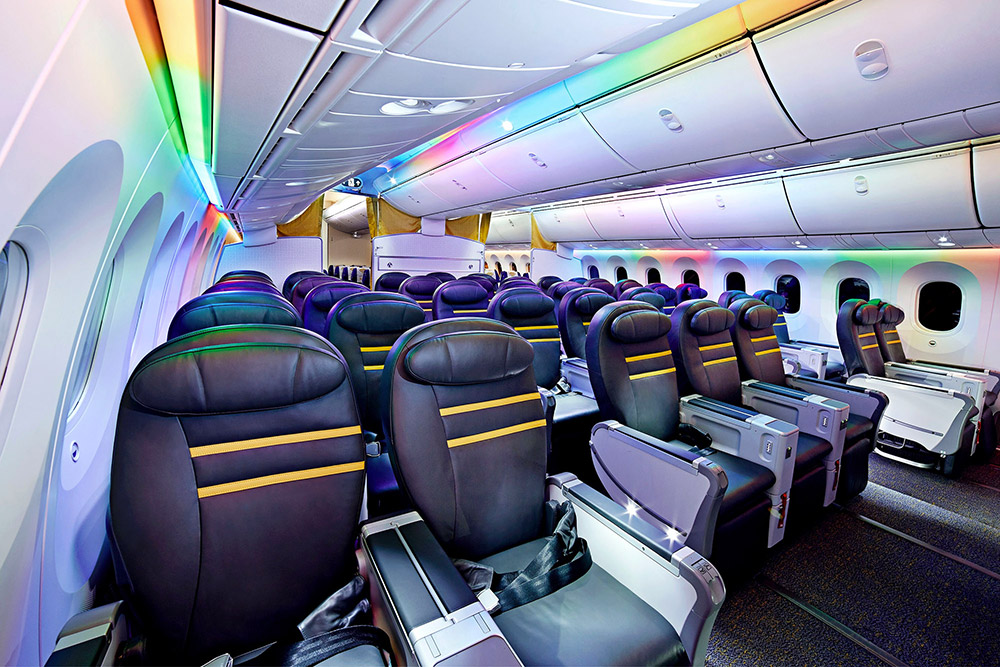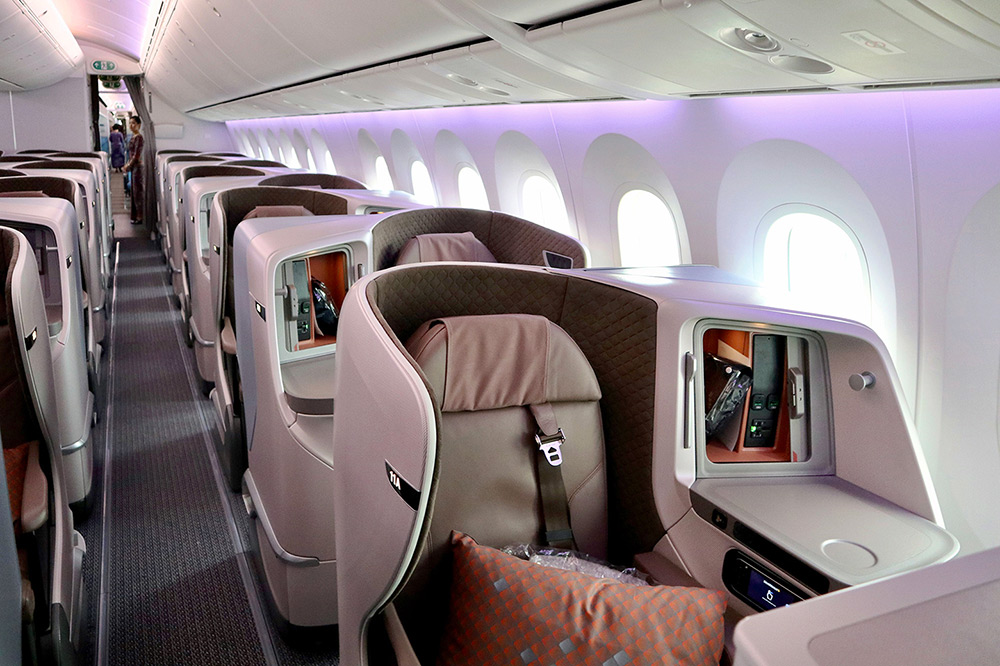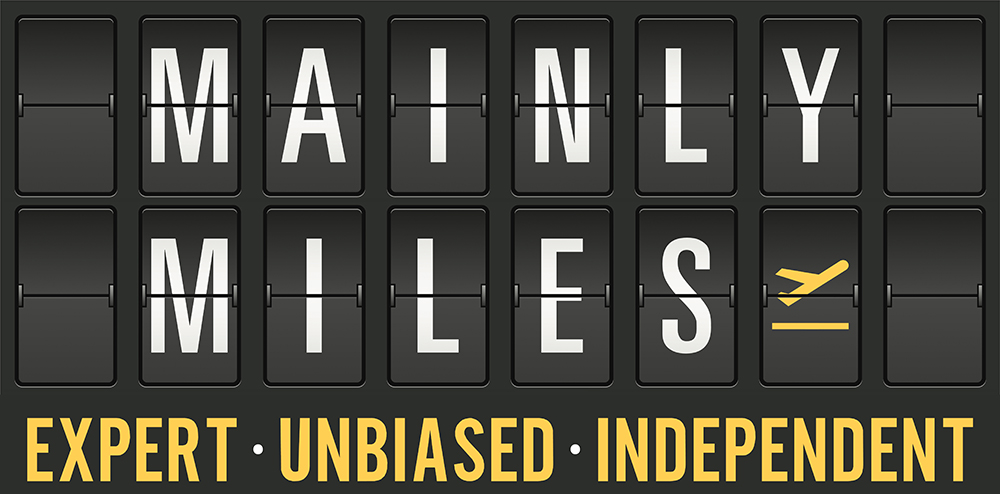Earlier this year Singapore Airlines reduced its large Boeing 787-10 order from a total of 44 aircraft to 30, as part of a swap which also increased its total Boeing 777-9 order from 20 aircraft to 31, while also agreeing to a slowed delivery schedule from the U.S. manufacturer due to the impact of the COVID-19 pandemic.
With 15 Boeing 787-10s already in service with SIA, the news meant only 15 more would be delivered to the carrier, instead of the original outstanding order for 29.
At the same time, SIA agreed a moderated delivery schedule with Airbus in relation to its A320, A321 and A350 orders over the coming years, though no changes to those order totals were made.
Scoot will take more 787s
Singapore Airlines has quietly transferred two of its outstanding 15 Boeing 787-10 orders to low-cost subsidiary Scoot, also converting them to the smaller 787-9 series.
Scoot currently has 20 Boeing 787s in its fleet and was previously taking an additional five examples; three of the 787-8 and two of the -9 variant.
The budget airline will now take a total of four Boeing 787-9s in the coming years, growing its wide-body fleet to 27 aircraft instead of a previously planned 25.

Here’s a summary of Scoot’s current fleet and future aircraft orders, following this change.

Aircraft Fleet & Orders
8 June 2021
| Aircraft Type | Capacity | In Fleet | On Order* |
| A320 | 180 | 26 | |
| A320neo | 186 | 5 | 28 |
| A321neo | 236 | 3 | 13 |
| 787-8 | 329 335 |
10 | 3 |
| 787-9 | 375 | 10 | 4 |
| Total | 54 | 48 |
* Includes aircraft ordered via lessors
Scoot’s new aircraft deliveries between now and March 2022 will comprise two Boeing 787-8s and seven Airbus A321neos, with other aircraft arriving in subsequent financial years.
SIA transfers five future Boeing 787-10s to lessors
In May 2021 Singapore Airlines announced that it had completed sale-and-leaseback deals on 11 of its owned aircraft, raising S$2 billion in liquidity to help it through the COVID-19 pandemic.
Four of these transactions applied to Boeing 787-10 aircraft, however the carrier has now confirmed to Mainly Miles that in addition, five of its remaining 787-10 orders have been transferred from SIA-owned to lessors.

“Singapore Airlines has adjusted its purchase agreement with Boeing. Five Boeing 787-10s will now be delivered to SIA through a third party. This will help SIA to reduce its near-term capital expenditure, and defer the introduction of these aircraft to a period that is better aligned with the projected recovery trajectory for international air travel.”
This will help SIA by shifting responsibility for payments due at various stages of the aircraft construction to the lessor in these cases, including the all-important final purchase settlement.
The lessor(s) involved have not been disclosed, with these five aircraft now listed by Boeing for “Unidentified Customer(s)”.

That means the airline will now take delivery of eight more Boeing 787-10s directly from Boeing, while the remaining five will come from leasing companies.
Once these 13 aircraft have been delivered, the final Singapore Airlines Boeing 787-10 fleet will stand at 28 aircraft, while Scoot’s Boeing 787 fleet will total 27 aircraft as outlined above (an almost equal split of 787-8 and 787-9 models).
| Singapore Airlines Boeing 787-10 Fleet |
|||
| Owned | Leased | Total | |
| In Service | 11 | 4 | 15 |
| On Order | 8 | 5 | 13 |
| Total | 19 | 9 | 28 |
As you can see, nine out of SIA’s final Boeing 787-10 fleet will be leased once all deliveries have been completed, around a third.

Singapore Airlines will take delivery of five Boeing 787-10s between now and March 2022, with the remaining eight penned in for future financial years.
The upcoming deliveries will likely be the owned aircraft coming directly from the manufacturer, since the airline has confirmed part of the reasoning for converting these five to lessor deliveries was to defer their introduction.
Why the changes?
Shifting Boeing 787-10 orders to the smaller 787-9 and transferring them to the low-cost arm is likely an indication of the SIA Group’s latest thinking on the regional market recovery trajectory post-pandemic.
Apart from the carrier’s Airbus A380s, the Boeing 787-10s have by far the highest capacity of any aircraft in the Singapore Airlines fleet, seating 337 passengers. That’s 11% more than the next-largest, the Airbus A350 Regional variant, accommodating 303 passengers.

These two types do not have crew rest bunks installed and are limited to regional flights within an approximate 7-hour radius from Singapore.
Doubtless one of the key considerations in shifting away from the larger Boeing 787-10 on regional flights has been the integration of the SilkAir fleet into SIA.
The process is now in the final stages, with SilkAir having already operated its final passenger flight in early May 2021, and is bringing a significant number of narrow-body aircraft into the mainline operation in the coming years:
- 9 x Boeing 737-800 (162 seats)
- 37 x Boeing 737-8 MAX (154 seats*)
* Configuration to be confirmed
Ultimately the leased Boeing 737-800s will be returned, but it will still give the airline a significant regional capability with the MAX, including flat-bed seats in Business Class and up to seven hours of range.

With post-COVID demand likely to look quite different, analysts are pointing towards passenger demand favouring point-to-point travel rather than the hub-and-spoke model SIA uses. Pre-pandemic, around a third of the airline’s passengers were connecting through Changi.
If forecasts are correct and this market does not return as buoyantly in the coming years, smaller capacity aircraft will be a better fit for many of SIA’s regional routes.
Rather than Boeing 787-10s and Airbus A350 Regionals on a specific route, for example, we may see only Airbus A350 Regionals to meet the larger ‘connection banks’, with Boeing 737-8 MAX aircraft operating ‘shoulder’ timings.
Another likely driver for an increase in the Scoot Boeing 787-9 fleet is the prediction that leisure travel will rebound first once borders reopen, meaning low-cost carriers are better placed to lead the recovery.
Summary
Scoot will have a larger Boeing 787 fleet in future with this latest transfer of two orders from Singapore Airlines, which should be a better match for demand recovery in the coming years compared to further increasing the SIA 787-10 fleet.
In addition, SIA has no doubt significantly reduced some of its future capital expenditure by transferring five of its Boeing 787-10 orders to leasing companies, effectively selling the aircraft before it even bought them.
Once delivered, a third of SIA’s final Boeing 787-10 fleet will be on operating leases rather than owned, potentially giving the airline flexibility to return some or all of these aircraft at the end of their initial lease periods, if the market conditions do not support the high capacity they offer.
No one knows exactly how demand and passenger choices will evolve over the next few years, nor how the industry will have to adapt to those factors, but Singapore Airlines seems to be making its ‘best guess’ with these latest tweaks to its future fleet plans.




I have been amused at watching SIA try and raise funds and conserve capital, at the same time running what must be luxuries such as the ultra long hauls to NYC. I think the general schedule already looks quite optimistic, but this is hard to gauge because it is unclear the impact of freight etc. But the fuel burn on ultra long hauls to the US make the freight proposition very questionable.